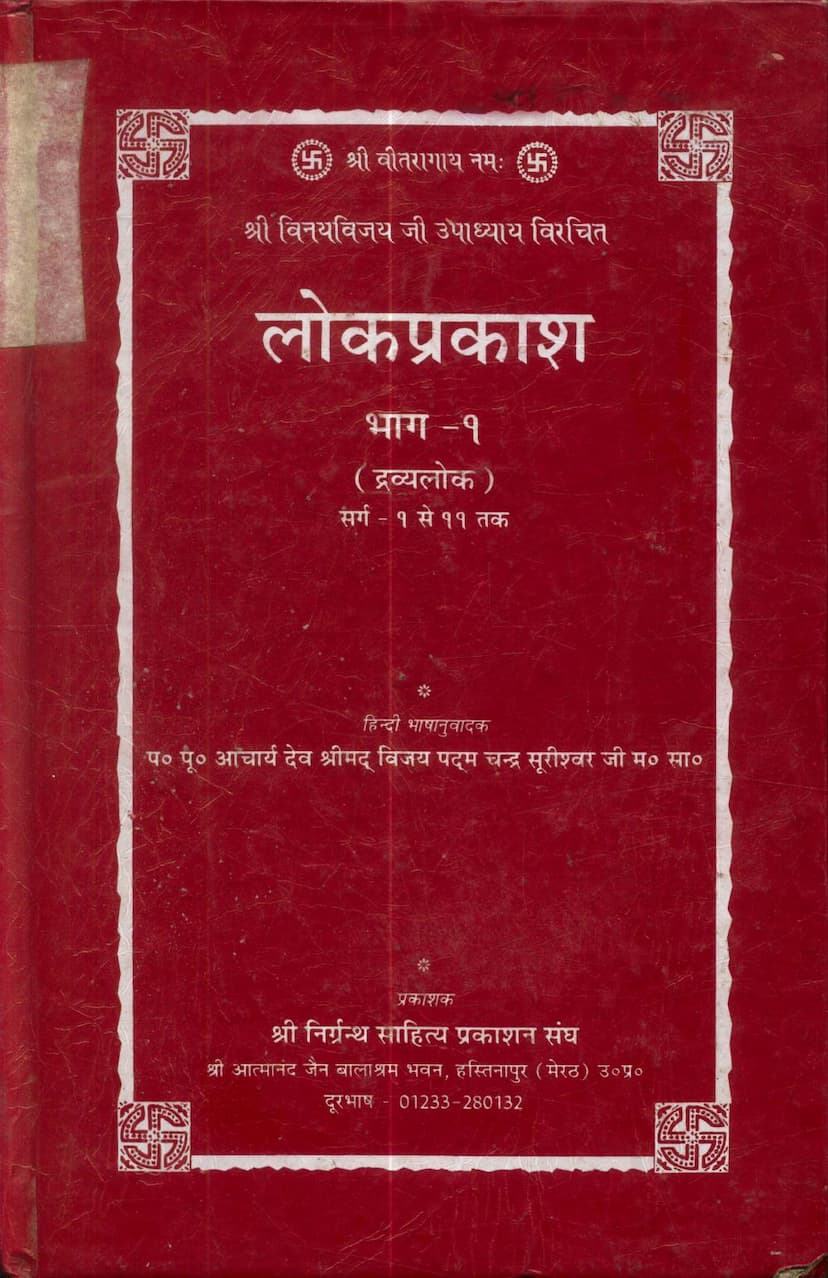Lokprakash Part 01
Added to library: September 2, 2025

Summary
Here's a comprehensive summary of the provided Jain text, "Lokprakash Part 01" by Acharya Shrimad Vijaya Padmachandrasuri, based on the content from the provided pages:
Overview:
"Lokprakash Part 01," authored by Acharya Shrimad Vijaya Padmachandrasuri, is a Hindi translation of the original work by Upadhyay Shrimad Vinay Vijay Ganivarya. Published by Shri Nirgranth Sahitya Prakashan Sangh, this volume covers the first eleven chapters (Sarg 1 to 11) of the "Dravya Lok" section. The book aims to present the vast and profound principles of Jain philosophy in a clear and accessible Hindi language, building upon the original Sanskrit and Gujarati translations. It is dedicated to the revered Guru Maharaj Shrimad Vijayanand Surishwar Ji.
Core Content and Themes:
This part of "Lokprakash" delves into the fundamental structure of the universe and the beings within it, as understood in Jain cosmology and philosophy. The summary within the text indicates that the original "Lok Prakash" is a voluminous work, comprising approximately 11,000 verses, and is divided into five parts, covering Dravya (Substance), Kshetra (Space), Kaal (Time), and Bhav (State/Quality).
Key Subjects Covered (Based on the detailed index and early chapters):
-
Mangaalcharan (Invocation): The text begins with auspicious salutations to Lord Parshvanath, Lord Shrinath, and other revered figures, setting a devotional tone.
-
Introduction to the Lok (Universe): The text introduces the concept of "Lok" (universe) as being fourfold:
- Dravya Lok: The realm of substances.
- Kshetra Lok: The realm of space.
- Kaal Lok: The realm of time.
- Bhav Lok: The realm of states or qualities.
-
Dravya (Substance): The initial chapters focus on the fundamental Jain concept of Dravya (Substance). The text meticulously explains:
- The Six Substances (Dravyas): Jiva (Soul), Ajiva (Non-soul) which is further divided into Dharma (Motion principle), Adharma (Stationary principle), Akash (Space), Kaal (Time), and Pudgal (Matter).
- Astikayas: The five substances that have extension in space (Dharma, Adharma, Akash, Jiva, Pudgal) and the concept of their "Padesha" (parts or extensions).
- Kaal (Time): The nature of time, its continuity, and its role.
- Measurement Units: Detailed explanations of the units of measurement used in Jain cosmology, such as:
- Angul (Finger): Discussed in three types - Utseedha Angul, Praman Angul, and Atma Angul, with intricate derivations from the smallest particle (paramanu).
- Yojana: A unit of spatial measurement.
- Rajju: The ultimate unit of measurement in the Lok, derived from Yojana.
- Palyopama & Sagaropama: Concepts of immense time periods, explained through elaborate analogies like filling a well with sesame seeds.
- Sankhyat, Asankhyat, Anant: The text introduces and explains the Jain understanding of numbers, quantities, and extents – countable, uncountable, and infinite – in relation to spatial and temporal dimensions.
-
Detailed Enumeration of Cosmic Structures:
- Lok (Universe): The structure of the Jaina universe is described, including its divisions into lower, middle, and upper realms.
- Naraka Bhumi (Hellish Regions): The seven hellish realms are mentioned.
- Dev Lok (Heavenly Regions): Various celestial realms are referenced.
- Tiryak Lok (Middle Realm): This section likely details the regions inhabited by beings with sensory perception, including continents (Dvipa) and oceans (Samudra).
-
Samsari Jiva (Mortal Souls): The text then begins to discuss the characteristics of mortal souls and their classification. The detailed index outlines a vast array of categories and subcategories for classifying living beings, including:
- Tiryak (Animals/Mortal Beings): Categorized by senses (ekendriya to panchendriya), states (sufficient/insufficient), states of life (sanchara/samudghaata), karma, etc.
- Dasha Dwar (Ten Principles/Categories): Mentioned in the context of classifying souls, including senses, consciousness, kashayas, sangya, ved, etc.
- Manusya (Humans): Discussed in detail, including their origins, types (samurcchima, garbhaja), life spans, and their relationship with other realms.
- Deva (Celestial Beings): Categorized into Bhavanpati, Vyantar, Jyotishka, and Vaimaanika.
- Naraka (Hellish Beings): Mentioned in the context of their locations and sufferings.
- Sthan (Places): Descriptions of where different types of beings reside.
- Leshya (Aura/Disposition): The six types of karmic dispositions (Krishna, Neel, Kapot, Tejas, Padma, Shukla).
- Karmas: A comprehensive exploration of the eight types of karmas and their numerous subcategories.
- Bodhi and Sambodhi: Different states of spiritual realization.
-
Author's Intent and Style: The author, Acharya Shri Padmachandrasuri, states the difficulty of the subject matter and his aim to simplify it for Hindi readers, drawing upon the wisdom of his predecessors. The text emphasizes the reliance on Agamic texts and the extensive citation of previous scholars, indicating a deep scholarly approach.
Translation and Scholarly Approach:
- Hindi Translation: The text is a Hindi translation, making the profound Jain doctrines accessible to a wider audience.
- Reference to Original Works: The translator and author frequently refer to the original works and commentaries, indicating a commitment to accuracy and faithfulness to the tradition.
- Citations: The inclusion of a long list of Agam texts and their specific locations (Sarg, Shlok) used as references underscores the meticulous and scholarly nature of the work.
- Biographical Information of the Original Author: The introduction provides a brief but detailed account of Upadhyay Shri Vinay Vijay Ji, his lineage, his gurus, and his vast literary contributions, highlighting his profound knowledge and dedication to Jain literature.
- The Translator's Dedication: The preface expresses deep reverence and gratitude towards the lineage of gurus, particularly Acharya Shrimad Vijayanand Surishwar Ji Maharaj, to whom the translated work is dedicated.
Significance:
"Lokprakash Part 01" serves as a gateway into the complex cosmology and metaphysics of Jainism. By translating and elucidating the "Dravya Lok," it aims to provide readers with a foundational understanding of the fundamental constituents of existence, the spatial and temporal frameworks, and the various states of beings within the Jain worldview. The translator's effort ensures that this ancient wisdom can be appreciated and studied by a contemporary Hindi-speaking audience.